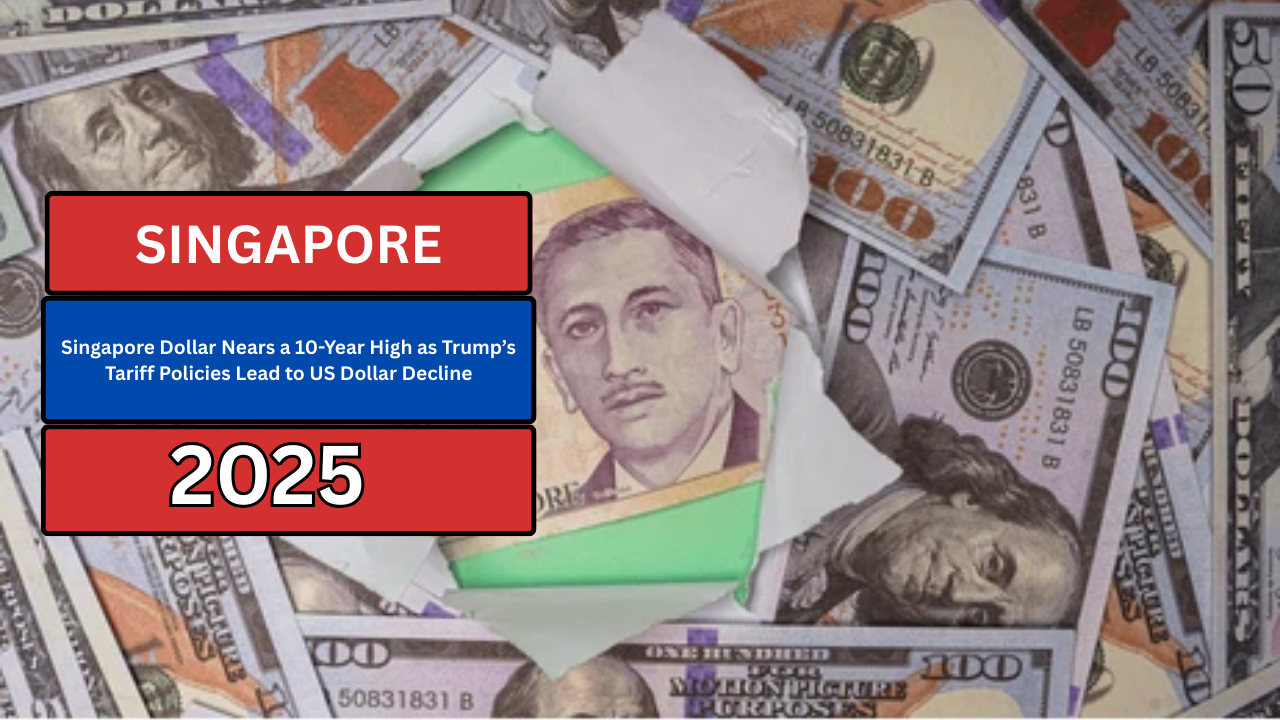The Singapore dollar has been steadily rising, inching closer to a 10-year high against the US dollar. This shift comes amid global financial turbulence sparked by former President Donald Trump’s trade policies, which have had long-lasting effects on international markets.
As the US dollar’s dominance wanes, many investors are looking to other currencies, with the Singapore dollar becoming a key beneficiary of this trend.
Impact of Trump’s Trade Tariffs on the US Dollar
When Trump took office in 2017, his aggressive trade policies and tariffs targeted China and other major trade partners, sparking tensions and disrupting global supply chains.
His “America First” agenda aimed to reduce the US trade deficit but came with significant consequences. These tariffs led to increased costs for American businesses and consumers, contributing to a weakening of the US dollar over time.
The ripple effects of Trump’s trade policies were felt around the world, as other countries adjusted their currencies and trade strategies.
The US dollar, historically the dominant global reserve currency, began to lose some of its strength, with countries looking for alternative safe-haven currencies.
The Rise of the Singapore Dollar

As the US dollar faced challenges, the Singapore dollar (SGD) has gained ground. Unlike many other currencies, the SGD has seen a steady rise, pushing closer to a 10-year high against the US dollar.
This rise can be attributed to Singapore’s strong economy, its political stability, and its reputation as a global financial hub.
Singapore, known for its business-friendly environment, has attracted foreign investment, further boosting the value of its currency.
The city-state’s strategic location in Asia has made it a crucial gateway for trade, and its economic policies have consistently supported its growth. As investors and corporations seek alternatives to the US dollar, the Singapore dollar stands out as a safe, reliable choice.
Factors Contributing to the Strengthening of the Singapore Dollar
- Economic Resilience: Singapore’s economy has proven to be resilient in the face of global challenges. The country has maintained steady growth in sectors such as finance, technology, and manufacturing. Its robust trade ties with China, India, and Southeast Asia also play a key role in supporting the SGD.
- Political Stability: The political stability in Singapore is another factor that makes the Singapore dollar appealing. The country has a strong, transparent government and a stable financial system, which provides confidence to foreign investors.
- Investment in Technology and Innovation: Singapore has become a hub for innovation, with significant investments in technology and digital transformation. This focus on the future has helped the economy remain competitive in the global market, further boosting the value of its currency.
- Capital Flows: As global uncertainty increases, many investors have sought safe-haven assets. Singapore, with its well-regulated financial markets and solid economic foundation, has seen an influx of capital. This has pushed up demand for the Singapore dollar, contributing to its appreciation.
- Interest Rate Differentials: The Singapore Monetary Authority has adopted a policy of managing the nominal effective exchange rate (NEER) to keep inflation in check while supporting growth. This policy has helped the SGD remain strong against the US dollar, especially when US interest rates were cut during Trump’s presidency to counteract economic slowdowns.
What Does This Mean for Global Markets?
The strengthening of the Singapore dollar has broader implications for global markets. As the US dollar’s dominance begins to decline, there is a noticeable shift towards regional currencies like the SGD.
Investors are increasingly looking for stable, lower-risk currencies that can serve as alternatives to the US dollar, particularly in light of trade tensions and uncertain global conditions.
Additionally, the rise of the Singapore dollar has sparked renewed interest in other Asian currencies, such as the Japanese yen and the Chinese yuan. These currencies, along with the SGD, may increasingly play a role in shaping the future of global finance, challenging the longstanding supremacy of the US dollar.
Impact on Singapore’s Trade and Economy
For Singapore, a stronger currency can have both positive and negative effects. On the positive side, a stronger Singapore dollar makes imports cheaper, which can help keep inflation in check.
Additionally, the country’s strong currency makes it an attractive destination for foreign investors, boosting its position as a financial hub in Asia.
However, there are potential downsides. A stronger Singapore dollar can make Singapore’s exports more expensive for foreign buyers.
This could impact industries like manufacturing, which are highly dependent on exports. The Singapore government and businesses will need to carefully manage this dynamic to maintain economic growth.
Global Reactions to the Decline of the US Dollar
The US dollar’s decreasing dominance has not gone unnoticed on the global stage. Central banks and financial institutions are rethinking their foreign exchange reserves and diversifying away from the dollar.
Some countries, particularly in Asia and Europe, are exploring ways to increase the use of their currencies in international trade and investment.
For instance, the European Union has been pushing for greater use of the euro in global markets, while China has been promoting the yuan as an alternative to the US dollar in trade agreements.
However, despite these efforts, the US dollar remains the most widely used currency in global trade, though it is facing more competition than ever before.
What Lies Ahead for the Singapore Dollar?
As the world continues to adjust to the changes brought about by Trump’s tariffs and their aftermath, the Singapore dollar’s rise is expected to continue.
However, its future performance will depend on several factors, including global economic conditions, regional trade developments, and the policies of the Singapore Monetary Authority.
With the US dollar weakening, Singapore’s currency could become even more prominent in international markets, offering a safe and stable alternative for investors and businesses alike.
Conclusion
The Singapore dollar’s steady rise to a 10-year high is a clear indication of the changing dynamics in global finance. The challenges faced by the US dollar, particularly the aftermath of Trump’s trade policies, have paved the way for currencies like the Singapore dollar to shine.
As the global market continues to evolve, the Singapore dollar’s strength signals a shift in financial power and influence in the years to come.



